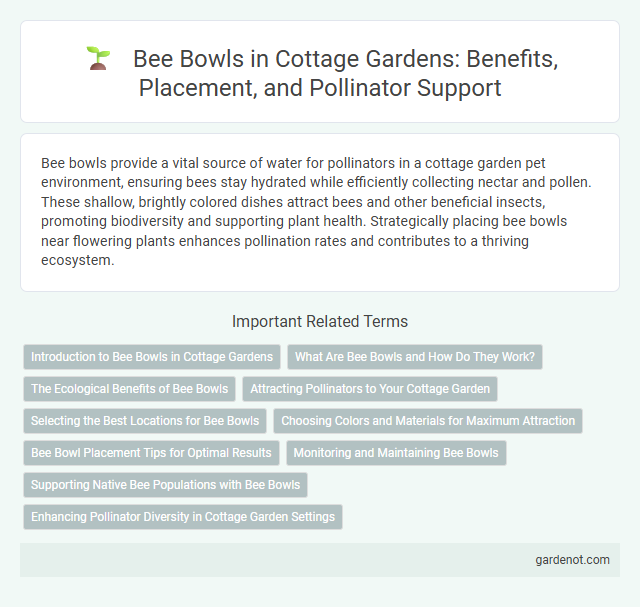Bee bowls provide a vital source of water for pollinators in a cottage garden pet environment, ensuring bees stay hydrated while efficiently collecting nectar and pollen. These shallow, brightly colored dishes attract bees and other beneficial insects, promoting biodiversity and supporting plant health. Strategically placing bee bowls near flowering plants enhances pollination rates and contributes to a thriving ecosystem.
Introduction to Bee Bowls in Cottage Gardens
Bee bowls are shallow, water-filled dishes placed in cottage gardens to provide bees with a safe drinking source, crucial for their hydration during hot weather. These simple yet effective tools help sustain local pollinator populations, enhancing the health and productivity of flowering plants and vegetable crops typical of cottage gardens. Strategically positioning bee bowls among diverse blooms supports biodiversity and promotes a thriving, eco-friendly garden ecosystem.
What Are Bee Bowls and How Do They Work?
Bee bowls are shallow containers filled with water and floating materials, designed to provide bees with a safe place to drink without drowning. These water sources mimic natural puddles, allowing pollinators to hydrate while resting on floating leaves or sticks. By supporting bee hydration, bee bowls play a crucial role in sustaining pollinator populations in cottage gardens.
The Ecological Benefits of Bee Bowls
Bee bowls provide a crucial habitat for solitary bee species, supporting pollination and biodiversity in cottage gardens. Their shallow, gently sloping design with water and pebbles allows bees to safely hydrate without drowning. These ecological benefits enhance the health of garden plants and promote sustainable ecosystems.
Attracting Pollinators to Your Cottage Garden
Bee bowls filled with a mix of water and small stones create safe landing spots that attract pollinators to your cottage garden, enhancing plant pollination and biodiversity. Position these shallow dishes near flowering plants to encourage bees and other beneficial insects to visit and hydrate, supporting their vital role in your garden's ecosystem. Incorporating bee bowls contributes to healthier plant growth and a vibrant, thriving cottage garden environment.
Selecting the Best Locations for Bee Bowls
Selecting the best locations for bee bowls involves placing them in sunny spots that mimic natural habitat conditions, such as near flowering plants rich in nectar and pollen. Positioning the bowls away from strong winds and heavy foot traffic ensures a safe and inviting environment for native bees to forage. Ideal sites also include elevated areas with good drainage to prevent water accumulation and maintain the effectiveness of the bee habitats.
Choosing Colors and Materials for Maximum Attraction
Selecting vibrant, nectar-rich flowers in shades of yellow, blue, and purple enhances bee attraction to a cottage garden bee bowl. Using natural materials like terracotta or unglazed ceramic for the bowl creates a safe, non-toxic environment preferred by pollinators. Incorporating a shallow water source with smooth stones inside the bowl ensures bees have easy access to hydration while foraging.
Bee Bowl Placement Tips for Optimal Results
Place the bee bowl in a sunny location within the cottage garden to attract the maximum number of solitary bees. Ensure the bowl is elevated slightly above ground level and surrounded by native wildflowers to provide both habitat and foraging resources. Avoid areas with heavy foot traffic or strong winds to maintain stability and prevent disturbance to visiting pollinators.
Monitoring and Maintaining Bee Bowls
Regular monitoring of bee bowls is essential to ensure accurate sampling of pollinator populations within cottage gardens. Maintaining bee bowls involves cleaning containers after each use, refilling with fresh, soapy water, and placing them in diverse garden locations to capture varied species data effectively. Proper upkeep promotes reliable ecological assessments and supports ongoing pollinator conservation efforts.
Supporting Native Bee Populations with Bee Bowls
Bee bowls provide vital hydration for native bee populations by offering shallow water sources that prevent drowning. These specially designed bowls encourage pollination activity in cottage gardens, enhancing plant biodiversity and ecosystem health. By supporting native bees, bee bowls contribute to sustaining local flora and balanced garden environments.
Enhancing Pollinator Diversity in Cottage Garden Settings
Bee bowls are essential tools for enhancing pollinator diversity in cottage garden settings by providing safe nesting habitats for solitary bees. These shallow, water-holding dishes attract a variety of native bee species, increasing pollination rates and supporting the overall ecosystem. Integrating bee bowls with native flowering plants improves biodiversity and ensures a healthy, thriving garden environment.
Bee bowl Infographic

 gardenot.com
gardenot.com